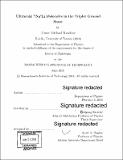| dc.contributor.advisor | Wolfgang Ketterle. | en_US |
| dc.contributor.author | Rvachov, Timur Michael | en_US |
| dc.contributor.other | Massachusetts Institute of Technology. Department of Physics. | en_US |
| dc.date.accessioned | 2018-11-15T16:37:07Z | |
| dc.date.available | 2018-11-15T16:37:07Z | |
| dc.date.copyright | 2018 | en_US |
| dc.date.issued | 2018 | en_US |
| dc.identifier.uri | http://hdl.handle.net/1721.1/119113 | |
| dc.description | Thesis: Ph. D., Massachusetts Institute of Technology, Department of Physics, 2018. | en_US |
| dc.description | Cataloged from PDF version of thesis. | en_US |
| dc.description | Includes bibliographical references (pages 161-173). | en_US |
| dc.description.abstract | This thesis describes experiments in spectroscopy and formation of triplet ²³Na⁶Li molecules from an initial mixture of ultracold ²³Na and ⁶Li. The production of quantum degenerate molecules with long-range dipolar interactions is a long-standing goal in low temperature physics. NaLi is a fermionic molecule with an electric dipole moment of 0.2 Debye and a magnetic dipole moment of 2 [mu]B in its triplet ro-vibrational ground state. The formation of an ultracold molecule with both electric and magnetic dipole moments allows for novel opportunities in control of ultracold molecular reactions and studies of quantum many-body systems with dipolar interactions. This experimental work consists of two parts. The first is a thorough spectroscopic study of the excited and ground triplet potentials of NaLi using one- and two-photon photoassociation spectroscopy. We present the spectroscopic positions and strengths of transitions to nearly all vibrational states in the excited c³[sigma]⁺ and ground ³[sigma]⁺ potentials of NaLi. This is the first spectroscopic observation of triplet potentials in NaLi and the first demonstration of photoassociation in the Na-Li system. The second part utilizes our spectroscopic results to coherently form an ultracold gas of NaLi molecules. Starting with an ultracold Na-Li mixture, we use magneto-association to form weakly bound Feshbach molecules. The Feshbach molecules are then transfered to the ro-vibrational triplet ground state using a two-photon stimulated Raman adiabatic passage (STIRAP) technique, forming 3 x 10⁴ molecules at a density of 5 x 10¹⁰ cm⁻³ and temperature of 3 [mu]K. The molecules are long-lived with a measured lifetime of 5 seconds, which highlights their fermionic nature and low universal inelastic loss rate. The utility of the molecule's magnetic moment is demonstrated by performing electron spin resonance spectroscopy to measure the hyperfine structure of the molecule. | en_US |
| dc.description.statementofresponsibility | by Timur Michael Rvachov. | en_US |
| dc.format.extent | 173 pages | en_US |
| dc.language.iso | eng | en_US |
| dc.publisher | Massachusetts Institute of Technology | en_US |
| dc.rights | MIT theses are protected by copyright. They may be viewed, downloaded, or printed from this source but further reproduction or distribution in any format is prohibited without written permission. | en_US |
| dc.rights.uri | http://dspace.mit.edu/handle/1721.1/7582 | en_US |
| dc.subject | Physics. | en_US |
| dc.title | Ultracold ²³Na⁶Li molecules in the triplet ground state | en_US |
| dc.type | Thesis | en_US |
| dc.description.degree | Ph. D. | en_US |
| dc.contributor.department | Massachusetts Institute of Technology. Department of Physics | |
| dc.identifier.oclc | 1059578061 | en_US |
